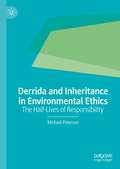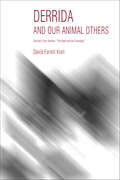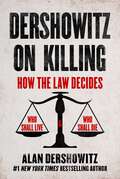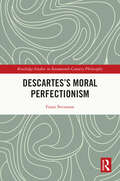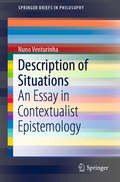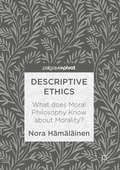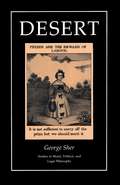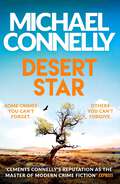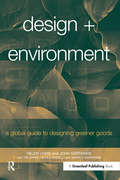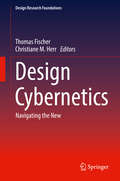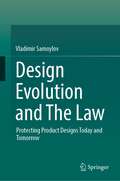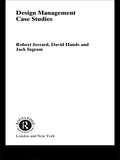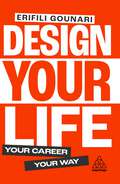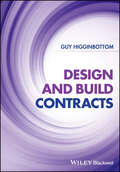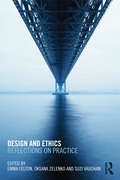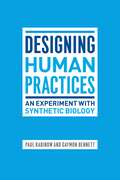- Table View
- List View
Dermatoethics: Contemporary Ethics and Professionalism in Dermatology
by Lionel Bercovitch Jane M. Grant-Kels Clifford S. Perlis Benjamin K. StoffThis extensively updated textbook reviews the ethical issues faced within dermatology. Bringing together practical real-life case scenarios and scholarly analysis, it covers the foundations of bioethics, as well as ethical issues associated with the various roles dermatologists play, including clinician, professional, educator, business person, and scholar. New chapters on the ethics of dermatologic care during pandemics, non-traditional interventions, private equity in dermatology, self-care and improvement, skin cancer screening, maintenance of certification, the ethics of clinical trial design are also included. Dermatoethics: Contemporary Ethics and Professionalism in Dermatology, 2nd Edition creates a dialogue around issues of ethics and professionalism within dermatology and is an essential text for both trainee and practicing dermatologists wishing to immerse themselves in the key questions in the discipline.
Derrida and Inheritance in Environmental Ethics: The Half-Lives of Responsibility
by Michael PetersonThis book argues for the necessity of a re-evaluation of our thinking about responsibly relating to future generations in the context of environmental philosophy. Using long-term nuclear waste disposal as its paradigmatic case, this book makes the case that the predominant mode of thinking the future in terms of continuity and repetition of the present requires a critique informed by French philosopher Jacques Derrida in order to think responsibility adequately. The book begins by surveying contemporary accounts of intergenerational responsibility before outlining the specifics of nuclear waste disposal policy. With these stakes established, the contributions of Jacques Derrida to future-oriented ethics are introduced. These include discussions of communication across contexts, the relationship between inheritance and responsibility, and the political imperatives that result from this critique. This book concludes by arguing for an intergenerational environmental policy that rejects policy and infrastructural projects that depend on the present reproducing itself indefinitely.
Derrida and Law: Derrida, Agamben, And The Political Theology Of Law (Philosophers And Law Ser.)
by Pierre LegrandThis volume gathers together sixteen seminal articles, all written by leading scholars, which articulate and effectuate the influence of Derrida's scholarship on the field of law. The articles included in this collection are underpinned by the authors' shared belief that the intellectual challenges posed by Derrida's work to legal scholarship are as challenging as they are pressing and as profound as they are inescapable. In addition to a thorough introduction addressing salient aspects of Jacques Derrida's engagement with law, this book comes with an extensive bibliography of sources in English. This provides the reader with a carefully selected list of more than one hundred texts, all of which serve as introductory pathways to Derrida's philosophy and in particular to the interaction between Derrida and law. A fine reminder of the trans-disciplinary influence of Jacques Derrida's thought, this landmark collection is destined to generate substantial interest in philosophy departments and law schools alike.
Derrida and Our Animal Others: Derrida's Final Seminar, "The Beast and the Sovereign" (Studies in Continental Thought)
by David Farrell KrellJacques Derrida's final seminars were devoted to animal life and political sovereignty—the connection being that animals slavishly adhere to the law while kings and gods tower above it and that this relationship reveals much about humanity in the West. David Farrell Krell offers a detailed account of these seminars, placing them in the context of Derrida's late work and his critique of Heidegger. Krell focuses his discussion on questions such as death, language, and animality. He concludes that Heidegger and Derrida share a commitment to finding new ways of speaking and thinking about human and animal life.
Derrida and Textual Animality: For a Zoogrammatology of Literature (Palgrave Studies in Animals and Literature)
by Rodolfo PiskorskiDerrida and Textual Animality: For a Zoogrammatology of Literature analyses what has come to be known, in the Humanities, as ‘the question of the animal’, in relation to literary texts. Rodolfo Piskorski intervenes in the current debate regarding the non-human and its representation in literature, resisting popular materialist methodological approaches in the field by revisiting and revitalising the post-structuralist thought of Derrida and the ‘linguistic turn’. The book focuses on Derrida’s early work in order to frame deconstructive approaches to literature as necessary for a theory and practice of literary criticism that addresses the question of the animal, arguing that texts are like animals, and animals are like texts. While Derrida’s late writings have been embraced by animal studies scholars due to its overt focus on animality, ethics, and the non-human, Piskorski demonstrates the additional value of these early Derridean texts for the field of literary animal studies by proposing detailed zoogrammatological readings of texts by Freud, Clarice Lispector, Ted Hughes, and Darren Aronofsky, while in dialogue with thinkers such as Butler, Kristeva, Genette, Deleuze and Guattari, and Attridge.
Dershowitz on Killing: How the Law Decides Who Shall Live and Who Shall Die
by Alan DershowitzIn Dershowitz on Killing: How the Law Decides Who Shall Live and Who Shall Die, Alan Dershowitz—New York Times bestselling author and one of America&’s most respected legal scholars—examines the subjects of death, life, and the law. Alan Dershowitz has been called &“one of the most prominent and consistent defenders of civil liberties in America&” by Politico and &“the nation&’s most peripatetic civil liberties lawyer and one of its most distinguished defenders of individual rights&” by Newsweek. His legal career as a criminal defense lawyer has been deeply involved with death and life decisions.Dershowitz on Killing is a timely examination of issues and questions that are front and center in today&’s society. Employing a philosophical, moral, religious, and cultural lens to the legal aspects surrounding death and life, Dershowitz elucidates the role of government to determine who shall live and who shall die in declaring wars, ordering executions, authorizing deadly force, permitting or denying abortions, providing or mandating vaccines, controlling climate change, allowing or refusing asylum for endangered migrants, and other life and death rulings. He notes that when the government decides these choices, it is asked to do so by first determining whether a &“right&” is involved, because rights trump mere interest, just as constitutional restrictions trump legislative and executive actions. Dershowitz on Killing asserts that the rules governing death and life decisions should reflect the irreversibility of death. It is essential reading for anyone interested in or concerned about how these decisions are allocated among state and federal; executive, legislative, and judicial; private and governmental; religious and secular institutions—and how people in a democracy, through the power of the ballot, have the ultimate say in these critical decisions.
Descartes’s Moral Perfectionism (Routledge Studies in Seventeenth-Century Philosophy)
by Frans SvenssonThis book offers a novel and comprehensive interpretation of Descartes’s moral philosophy. In contrast to other influential interpretations, the book argues that the central tenet of his ethical thought is that each person ought to live in the way that is most conducive to their degree of overall perfection.While Descartes’s ethical thought has attracted only a very modest amount of attention among scholars, this book demonstrates that it constitutes an important and integral component of his philosophical project as a whole. It argues that Descartes’s ethics constitutes a form of moral perfectionism. In the Cartesian picture, we satisfy this requirement of perfection by using our free will well in all our conduct, something which is also necessary for obtaining happiness for ourselves. To be guaranteed happiness, however, we need to acquire the virtue of generosity, which, besides a habit of using one’s free will well, entails a habit of being attentive in one’s thought to various truths about oneself and about the world we live in. Descartes offers an interesting attempt to make living well depend entirely on ourselves and not on fate or fortune. He also leaves room for the presence of passions within such a life and for acknowledging that even fully virtuous persons’ lives may differ in their degrees of overall perfection.Descartes’s Moral Perfectionism will appeal to scholars and graduate students working on Descartes, the history of early modern philosophy, and the history of ethics.
Description of Situations: An Essay in Contextualist Epistemology (SpringerBriefs in Philosophy)
by Nuno VenturinhaThis book approaches classic epistemological problems from a contextualist perspective. The author takes as his point of departure the fact that we are situated beings, more specifically that every single moment in our lives is already given within the framework of a specific context in the midst of which we understand ourselves and what surrounds us.In the process of his investigation, the author explores, in a fresh way, the works of key thinkers in epistemology. These include Bernard Bolzano, René Descartes, Gottlob Frege, Edmund Husserl, Immanuel Kant and Ludwig Wittgenstein, but also contemporary authors such as Stewart Cohen, Keith DeRose, David Lewis, Duncan Pritchard, Ernest Sosa and Charles Travis. Some of the topics covered are attributions of knowledge, the correspondence theory of truth, objectivity and subjectivity, possible worlds, primary and secondary evidence, scepticism, transcendentalism and relativism. The book also introduces a new contextualist thought-experiment for dealing with moral questions.Contextualism has received a great deal of attention in contemporary epistemology. It has the potential to resolve a number of issues that traditional epistemological approaches cannot address. In particular, a contextualist view opens the way to an understanding of those cognitive processes that require situational information to be fully grasped. However, contextualism poses serious difficulties in regard to epistemic invariance. This book offers readers an innovative approach to some fundamental questions in this field.
Descriptive Ethics
by Nora HämäläinenThis book is an investigation into the descriptive task of moral philosophy. Nora H#65533;m#65533;l#65533;inen explores the challenge of providing rich and accurate pictures of the moral conditions, values, virtues, and norms under which people live and have lived, along with relevant knowledge about the human animal and human nature. While modern moral philosophy has focused its energies on normative and metaethical theory, the task of describing, uncovering, and inquiring into moral frameworks and moral practices has mainly been left to social scientists and historians. Nora H#65533;m#65533;l#65533;inen argues that this division of labour has detrimental consequences for moral philosophy and that a reorientation toward descriptive work is needed in moral philosophy. She traces resources for a descriptive philosophical ethics in the work of four prominent philosophers of the twentieth century: John Dewey, Ludwig Wittgenstein, Michel Foucault, and Charles Taylor, while also calling on thinkers inspired by them.
Desegregating Private Higher Education in the South: Duke, Emory, Rice, Tulane, and Vanderbilt
by Melissa KeanAfter World War II, elite private universities in the South faced growing calls for desegregation. Though, unlike their peer public institutions, no federal court ordered these schools to admit black students and no troops arrived to protect access to the schools, to suggest that desegregation at these universities took place voluntarily would be misleading In Desegregating Private Higher Education in the South,Melissa Kean explores how leaders at five of the region's most prestigious private universities -- Duke, Emory, Rice, Tulane, and Vanderbilt -- sought to strengthen their national position and reputation while simultaneously answering the increasing pressure to end segregation.To join the upper echelon of U. S. universities, these schools required increased federal and northern philanthropic funding. Clearly, to receive this funding, schools had to eliminate segregation, and so a rift appeared within the leadership of the schools. University presidents generally favored making careful accommodations in their racial policies for the sake of academic improvement, but universities' boards of trustees -- the presidents' main opponents -- served as the final decision-makers on university policy. Board members--usually comprised of professional, white, male alumni--reacted strongly to threats against southern white authority and resisted determinedly any outside attempts to impose desegregation.The grassroots civil rights movement created a national crisis of conscience that led many individuals and institutions vital to the universities' survival to insist on desegregation. The schools felt enormous pressure to end discrimination as northern foundations withheld funding, accrediting bodies and professional academic associations denied membership, divinity students and professors chose to study and teach elsewhere, and alumni withheld contributions. The Brown v. Board of Education decision in 1954 gave the desegregation debate a sense of urgency and also inflamed tensions -- which continued to mount into the early 1960s. These tensions and the boards' resistance to change created an atmosphere of crisis that badly eroded their cherished role as southern leaders. When faced with the choice between institutional viability and segregation, Kean explains, they gracelessly relented, refusing to the end to admit they had been pressured by outside forces.Shedding new light on a rare, unexamined facet of the civil rights movement, Desegregating Private Higher Education in the South fills a gap in the history of the academy.
Desert (Studies in Moral, Political, and Legal Philosophy #3)
by George SherThe description for this book, Desert, will be forthcoming.
Desert Collapses: Why No One Deserves Anything (Routledge Studies in Ethics and Moral Theory)
by Stephen KershnarPeople consider desert part of our moral world. It structures how we think about important areas such as love, punishment, and work. This book argues that no one deserves anything. If this is correct, then claims that people deserve general and specific things are false. At the heart of desert is the notion of moral credit or discredit. People deserve good things (credit) when they are good people or do desirable things. These desirable things might be right, good, or virtuous acts. People deserve bad things (discredit) when they are bad people or do undesirable things. On some theories, people deserve credit in general terms. For instance, they deserve a good life. On other theories, people deserve credit in specific terms. For instance, they deserve specific incomes, jobs, punishments, relationships, or reputations. The author’s argument against desert rests on three claims: There is no adequate theory of what desert is. Even if there were an adequate theory of what desert is, nothing grounds (justifies) desert. Even if there were an adequate theory of what desert is and something were to ground it, there is no plausible account of what people deserve. Desert Collapses will be of interest to researchers and advanced students working in ethics and political philosophy.
Desert Star: The Brand New Blockbuster Ballard & Bosch Thriller
by Michael ConnellyTHE WORLDWIDE #1 BESTSELLER BEHIND AMAZON PRIME'S BOSCH AND NETFLIX'S THE LINCOLN LAWYERSOME CRIMES YOU CAN'T FORGET.Detective Renée Ballard is given the chance of a lifetime: revive the LAPD's cold case unit and find justice for the families of the forgotten. The only catch is they must first crack the unsolved murder of the sister of the city councilman who is sponsoring the department - or lose everything...OTHERS YOU CAN'T FORGIVE.Harry Bosch is top of the list of investigators Ballard wants to recruit. The former homicide detective is a living legend - but for how long? Because Bosch has his own agenda: a crime that has haunted him for years - the murder of a whole family, buried out in the desert - which he vowed to close.WHAT WOULD YOU DO IF YOU KNEW WHO DID IT?With the killer still out there and evidence elusive - Bosch is on a collision course with a choice he hoped never to make...* * * * *CRIME DOESN'T COME BETTER THAN CONNELLY:'The pre-eminent detective novelist of his generation'IAN RANKIN'The best mystery writer in the world'GQ'One of the greatest crime writers'DAILY MAIL'A superb natural storyteller'LEE CHILD'A master'STEPHEN KING'A genius'INDEPENDENT ON SUNDAY'Crime thriller writing of the highest order'GUARDIAN'A terrific writer with pace, style and humanity to spare'THE TIMES'America's greatest living crime writer'DAILY EXPRESS'One of the great storytellers of crime fiction'SUNDAY TELEGRAPH
Design + Environment: A Global Guide to Designing Greener Goods
by Helen Lewis Tim Grant John Gertsakis Nicola Morelli Andrew SweatmanThere is a huge scarcity of good, practical resources for designers and students interested in minimizing the environmental impacts of products. Design + Environment has been specifically written to address this paucity. The book first provides background information to help the reader understand how and why design for environment (DfE) has become so critical to design, with reference to some of the most influential writers, designers and companies in the field. Next, Design + Environment provides a step-by-step approach on how to approach DfE: to design a product that meets requirements for quality, cost, manufacturability and consumer appeal, while at the same time minimising environmental impacts. The first step in the process is to undertake an assessment of environmental impacts, using life-cycle assessment (LCA) or one of the many simpler tools available to help the designer. From then on, DfE becomes an integral part of the normal design process, including the development of concepts, design of prototypes, final design and development of marketing strategies. Environmental assessment tools and strategies to reduce environmental impacts, such as the selection of appropriate materials, are then discussed. Next, some of the links between environmental problems, such as global warming, ozone depletion, water and air pollution and the everyday products we consume are considered. In order to design products with minimal environmental impact, we need to have a basic understanding of these impacts and the interactions between them. The four subsequent chapters provide more detailed strategies and case studies for particular product groups: packaging, textiles, furniture, and electrical and electronic products. Guidelines are provided for each of the critical stages of a product's life, from the selection of raw materials through to strategies for recovery and recycling. Finally, Design + Environment takes a look at some of the emerging trends in DfE that are offering us the opportunity to make a more significant reduction in environmental impacts. Both the development of more sustainable materials and technologies and the growing interest in leasing rather than selling products are examined. Design + Environment is organized as a workbook rather than an academic text. It should be read once, and then used as a key reference source. This clear and informative book will prove to be invaluable to practising designers, to course directors and their students in need of a core teaching and reference text and to all those interested in learning about the tools and trends influencing green product design. The authors have all been involved in an innovative demonstration programme called "EcoReDesign", which was developed by the Centre for Design at RMIT University with funding from the Australian government. The Centre successfully collaborated with Australian companies to improve the environmental performance of their products by following DfE principles.
Design Cybernetics: Navigating the New (Design Research Foundations)
by Thomas Fischer Christiane M. HerrDesign Cybernetics: Navigating the New Design cybernetics offers a way of looking at ourselves – curious, creative, and ethical humans – as self-organising systems that negotiate their own goals in open-ended explorations of the previously unknown. It is a theory of and for epistemic practices (learning, designing, researching) that is deeply committed to the autonomy of others and hence offers no prescriptive methodology. Design cybernetics describes design practice as inextricable from conversation – a way of enquiring, developing shared understanding and reaching the new that harnesses reliable control as well as error and serendipity. Recognising circular causality, observer-dependency and non-determinability, design cybernetics extends beyond tenets of scientific research into the creative, ethical and aesthetic domain. From this perspective, design is not an ill-conceived subset of scientific research. Instead, scientific research emerges as a particularly restricted subset of the broader human activity of design. This volume offers a cross-section of design cybernetic theory and practice with contributions ranging across architecture, interior lighting studies, product design, embedded systems, design pedagogy, design theory, social transformation design, research epistemology, art and poetics, as well as theatre and acting. Addressing designers, design educators and researchers interested in a rigorous, practice-based epistemology, it establishes design cybernetics as a foundational perspective of design research. “This is a conceptually elegant, well structured, and comprehensive presentation of design cybernetics. It fills a gap in the literature of the field.” Ken Friedman, Chair Professor, Tongji University “This book offers a valuable and timely introduction to second-order cybernetics as society grapples with complex issues like climate change and rising inequality.” Joichi Ito, Director of the MIT Media Lab
Design Evolution and The Law: Protecting Product Designs Today and Tomorrow
by Vladimir SamoylovThis book focuses on product design which is evolving conceptually and practically with advances in technology. Product design is no longer solely about product stylization and decoration, but rather about providing a holistic product experience for the consumer. Therefore, in the foreseeable future, product designs will increasingly communicate not only to our eyes, but to our other senses as well.This book examines the frameworks for the protection of product designs in New Zealand and Australia and evaluates the appropriateness of expanding legal mechanisms for the accommodation of product design evolution. The value of more holistic design protection is balanced against other important considerations such as the “right to repair".The book not only anticipates the extent to which product design will cater to senses other than visual, but also provides a novel framework (with reference to industry examples) for discerning originality in such work for the purposes of copyright. This book also makes suggestions for how designs can be protected from foreseeable infringement (analogous to copyright infringement of music and movies on file sharing networks) resulting from future advances in technologies such as 3D printing and virtual reality.
Design Management Case Studies
by David Hands Robert Jerrard Jack IngramFirst Published in 2002. Routledge is an imprint of Taylor & Francis, an informa company.
Design Your Life: Your Career, Your Way
by Erifili GounariWe don't have to conform to traditional ways of working. Uncover how to build a successful career on your own terms and develop the skills you need for the future with Design Your Life. Why settle with a conventional career path when you can build a future on your own terms? With innovations such as side gigs and personal branding, you can craft your own, authentic future. Design Your Life uncovers the key skills and strategies that will allow you to build a successful career as a young professional. In this book, Gen Z business leader and expert Erifili Gounari draws upon original research and first-hand interviews to uncover how you can thrive and find success in this new world of work, creating a career with flexibility and ownership.
Design and Build Contracts
by Guy HigginbottomDESIGN AND BUILD CONTRACTS Design and build (D&B) construction procurement relies on a project’s main contractor shouldering the responsibility for creating the design and executing the construction for a project. While the extent of contractor-produced design can vary, this method of construction procurement affords the contractor a greater level of input and responsibility than traditionally procured contracts (where the employer has greater design responsibility). Over the last decade in the UK, it has become clear that D&B contracts are becoming the most popular method for procuring construction projects; often echoing the ways in which contracts for infrastructure and process plant can be procured. Whilst D&B can provide a greater degree of contractor input for producing feasibility and concept designs, then the detailed design to deliver a project, many clients amend standard forms of D&B contracts to alter the contractors’ design input. This can significantly change D&B, deviating from the procedures set out in the standard forms of D&B contract. This book firstly takes the reader through each stage of a project (based upon the RIBA Plan of Work 2020) to provide guidance on how D&B contracts were intended to operate, then secondly, identifying how D&B contracts and their procedures have changed. Readers will find: Outline commentary and guidance on commonly used standard forms of D&B contract, including: JCT Design and Build 2016; FIDIC Conditions of Contract for Plant Design-Build 2017; and NEC4 How each D&B contract is intended to operate during each stage of the RIBA Plan of Work 2020 How the operation of D&B contracts and their procedures are often amended. An ideal resource for contractors, employers, and consultants, as well as those studying construction at university, Design and Build Contracts offers helpful commentary and guidance for how each stage of a D&B engineering or construction project should progress.
Design and Ethics: Reflections on Practice
by Emma Felton Oksana Zelenko Suzi VaughanThe value of design for contributing to environmental solutions and a sustainable future is increasingly recognised. It spans many spheres of everyday life, and the ethical dimension of design practice that considers environmental, social and economic sustainability is compelling. Approaches to design recognise design as a practice that can transform human experience and understanding, expanding its role beyond stylistic enhancement. The traditional roles of design, designer and designed object are therefore redefined through new understanding of the relationship between the material and immaterial aspects of design where the design product and the design process are embodiments of ideas, values and beliefs. This multi-disciplinary approach considers how to create design which is at once aesthetically pleasing and also ethically considered, with contributions from fields as diverse as architecture, fashion, urban design and philosophy. The authors also address how to teach design based subjects while instilling a desire in the student to develop ethical work practices, both inside and outside the studio.
Design for Liberty: Private Property, Public Administration, and the Rule of Law
by Richard A. EpsteinFollowing a vast expansion in the twentieth century, government is beginning to creak at the joints under its enormous weight. The signs are clear: a bloated civil service, low approval ratings for Congress and the President, increasing federal-state conflict, rampant distrust of politicians and government officials, record state deficits, and major unrest among public employees. In this compact, clearly written book, the noted legal scholar Richard Epstein advocates a much smaller federal government, arguing that our over-regulated state allows too much discretion on the part of regulators, which results in arbitrary, unfair decisions, rent-seeking, and other abuses. Epstein bases his classical liberalism on the twin pillars of the rule of law and of private contracts and property rights—an overarching structure that allows private property to keep its form regardless of changes in population, tastes, technology, and wealth. This structure also makes possible a restrained public administration to implement limited objectives. Government continues to play a key role as night-watchman, but with the added flexibility in revenues and expenditures to attend to national defense and infrastructure formation. Although no legal system can eliminate the need for discretion in the management of both private and public affairs, predictable laws can cabin the zone of discretion and permit arbitrary decisions to be challenged. Joining a set of strong property rights with sound but limited public administration could strengthen the rule of law, with its virtues of neutrality, generality, clarity, consistency, and forward-lookingness, and reverse the contempt and cynicism that have overcome us.
Design in Legal Education (Emerging Legal Education)
by Emily AllbonThis visually rich, experience-led collection explores what design can do for legal education. In recent decades design has increasingly come to be understood as a resource to improve other fields of public, private and civil society practice; and legal design—that is, the application of design-based methods to legal practice—is increasingly embedded in lawyering across the world. It brings together experts from multiple disciplines, professions and jurisdictions to reflect upon how designerly mindsets, processes and strategies can enhance teaching and learning across higher education, public legal information and legal practice; and will be of interest and use to those teaching and learning in any and all of those fields.
Designed to Kill: The Case Against Weapons Research
by John ForgeThe pilot-less drones, smart bombs and other high-tech weapons on display in recent conflicts are all the outcome of weapons research. However, the kind of scientific and technological endeavour has been around for a long time, producing not only the armaments of Nazi Germany and the atomic bombs dropped on Japan, but the catapults used in ancient Greece and Rome and the assault rifles used by child soldiers in Africa. In this book John Forge examines such weapons research and asks whether it is morally acceptable to undertake such an activity. He argues that it is in fact morally wrong to take part in weapons research as its primary purpose is to produce the means to harm others, and moreover he argues that all attempts to then justify participation in weapons research do not stand up to scrutiny. This book has wide appeal in fields of philosophy and related areas, as well to a more general audience who are puzzled about the rate at which new weapons are accumulated.
Designing Flexible Cash Flows
by Scott FawcettWhether calculating a net present value, assessing an internal rate of return, or considering the impact of debt on a transaction when analysing investments in property it is very hard to get away from the need for cashflows. These cashflows range from the very simple to the extremely complex and can take anything from minutes to days to produce. Of course, valuation software exists that will produce these for you - but sometimes there are situations where you can't avoid having to do the job yourself!
Designing Human Practices: An Experiment with Synthetic Biology
by Paul Rabinow Gaymon BennettIn 2006 anthropologists Paul Rabinow and Gaymon Bennett set out to rethink the role that human sciences play in biological research, creating the Human Practices division of the Synthetic Biology Engineering Research Center—a facility established to create design standards for the engineering of new enzymes, genetic circuits, cells, and other biological entities—to formulate a new approach to the ethical, security, and philosophical considerations of controversial biological work. They sought not simply to act as watchdogs but to integrate the biosciences with their own discipline in a more fundamentally interdependent way, inventing a new, dynamic, and experimental anthropology that they could bring to bear on the center’s biological research. Designing Human Practices is a detailed account of this anthropological experiment and, ultimately, its rejection. It provides new insights into the possibilities and limitations of collaboration, and diagnoses the micro-politics which effectively constrained the potential for mutual scientific flourishing. Synthesizing multiple disciplines, including biology, genetics, anthropology, and philosophy, alongside a thorough examination of funding entities such as the National Science Foundation, Designing Human Practices pushes the social study of science into new and provocative territory, utilizing a real-world experience as a springboard for timely reflections on how the human and life sciences can and should transform each other.

